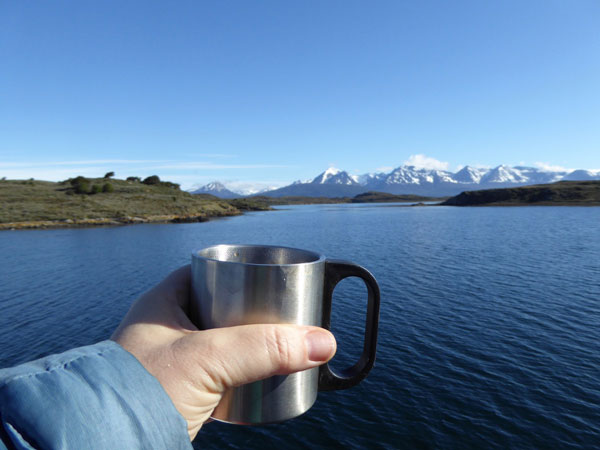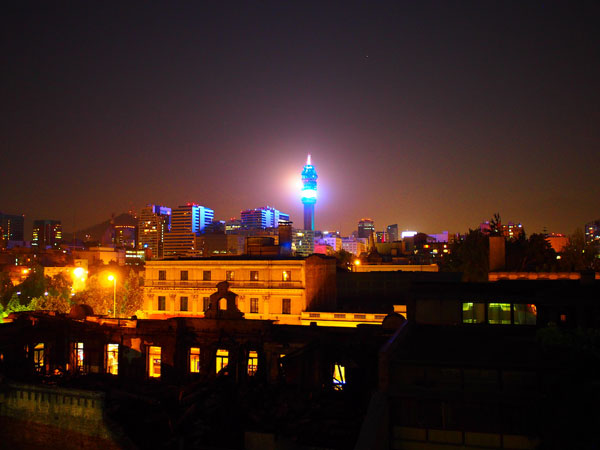It’s me again. With the language thing.
The other night, I was at a friend’s apartment in Ñuñoa, a pretty residential neighborhood with probably the swankiest and most pleasant plaza in all of Santiago with a giant fountain and benches and places where you have to step over the ornamental bushes to sit on the grass and make out if you are a teenager, which I am not.
And there at the house, we were eating a homemade pie de limón (how did I not already know my friend could make this “Chilean” dessert which bears a striking resenblance to key lime pie, except it’s made with regular lemons, but it has the cookie crust and the meringue top and all that.) And while we were eating the pie and the lemon zest was making its presence known, someone started telling a story of some far away childhood time when people were giving each other piggy-back rides.
And I intuitively knew what they were talking about, but didn’t recognize the expression “a cuestas” that I thought I knew for this, and so I backed them up a bit so I could get the exact expression they had used. The only kids I spend a lot of time with also speak Portuguese, and whatever they say for piggy back ride is not this.
“Alapa” they said. (or so I heard).
So I divided up the word as best I could and got “a lapa.”
Which means, something to the gist of “like a limpet.”
What? You know not this limpet thing? Let me take you by the hand and introduce you to some limpets I met in New Zealand.
These are limpets, or lapas here in the Spanish-speaking world. They’re basically a small mollusk that holds onto the rock with their muscle side, and the single shell is out towards you. You can’t pull them off a rock with your fingers, and to say that someone “se te pega como lapa” (sticks to you like a limpet) means they’re a person that gloms onto you and won’t let you go. They stick to you like glue. And having as much coast as we do, there are all kinds of ocean-sayings in Chile, with my favorite possibly being “es un lastre” which means “he’s a drag,” as lastre is the word for ballast. (or maybe this is not Chilean, advise dear readers, please do).
But back to the lapas, which were photographed at the Moeraki boulders, which you’ve already seen, but look how pretty, again!
Anyway, I was happy, I had a visual to help me remember, and I was now in the ownership of how to say “piggy-back ride” in Chilean Spanish. Plus I had the pie de limón. What could be bad?
And I repeated it back, and with that surgical precision that helps Spanish-speakers to hear a difference between ardilla (squirrel) and ardía (it was burning), they immediately heard that I’d had a little case of what I like to call “l migration.”
My l was on the wrong side of the word divide, because it is not “a lapa” but “al apa,” from the Quechua apa, which means load, as in a load of something. As in when a person is heavily laden. And yes, I had to look that up, of course. Aside from a few words I learned living with a family in Ecuador, I don’t speak Quechua.
But when you give some kids a piggy back ride, some of them stick on like glue. Which will help me to remember this whole misunderstanding if my Quechua ever fails, which I think it already did.












My friend who visited in December did her Honors thesis on Limpits in Maine and when we went to Coquimbo she went nuts trying to find Limpit shells (they are apparently a different variety). She also discovered in the fish market that you can eat Limpits (and I discovered the word for limpits!) I kind of like "a lapa" better than "al apa"…although I guess the second one makes a little more sense.
Also, isn't pie de limon just lemon meringue pie?
Yes, it is "al apa", but I think the "lapa" version is way better than the quechua one.
Abby, I have seen a lot of lapas around the litoral central, esp. near Isla Negra, but I don't know how she could get the shells, as the ones I saw were still live.
And pie de limón isn't lemon meringue pie because lemon meringue pie has a regular shortening crust, and pie de limon has a tart or crumb crust, and also the lemon goo in lemon meringue pie is gelled with cornstarch and is a high layer, and in pie de limón it's more of a custard made with condensed milk. Plus lemon meringue pie is really, really ucky, and pie de limón is not my favorite, but I can concede that when it's good it's quite good.
Marmo, I know, isn't "a lapa" so cute? You can understand why I misheard. I also found out that "upa" was to carry someone in your arms in the front (they contrasted al apa and al upa), but I didn't find a good etymology for that. Any ideas? Does it come from German, or English, do you think?
"Upa" caught my curiosity, it comes from "aupa", (aupar):
Del verbo aupar: (conjugar)
aúpa es:
3ª persona singular (él/ella/usted) presente indicativo
2ª persona singular (tú) imperativo
Diccionario de la lengua española © 2005 Espasa-Calpe:
¡aúpa!
interj. Se usa para animar a alguien a levantarse o levantar algo:
¡aúpa, que no ha sido nada!
Expresión que utilizan los niños para pedir que les lleven en brazos:
¡aúpa, mamá!
At first I thought, like you, that upa was related to "up", but in that case it would have been transformed in something like "ap", since spanish has a different use of vowels.
"Upa" and its older form "aúpa", (according to other cryptic internet source that I can´t find right now to link) come from Asturias and Galicia, and are old expresions in spanish.
Haha… Yes, I think it is the language nerd in you talking. I am a closet language nerd, but I don't come out to play because I'm shy. Anyways, I have little inner dialogue with myself almost daily like "Did he say that? Or was it this? Because in that case it would be embarassing if I answered this…" And so on.
I always thought it was a lapa too. And I love the word limpet, or hate it, I can't decide.